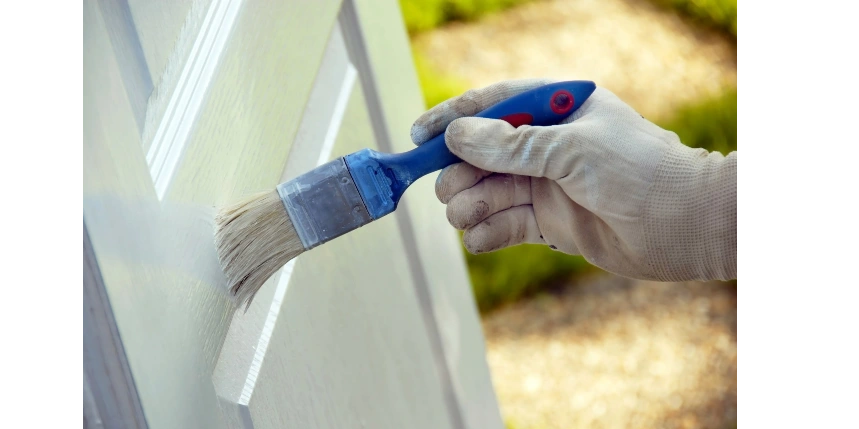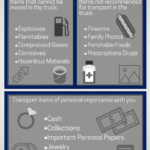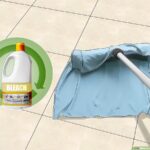To clean doors before painting, first remove dirt and grime using a mild detergent and water solution. Rinse and dry thoroughly.
Cleaning doors before painting ensures a smooth finish and enhances paint adhesion. Dust, dirt, and grease can prevent paint from sticking properly. Use a mild detergent mixed with water to wipe down the door surface. Pay attention to corners and edges, where grime often accumulates.
After cleaning, rinse with clean water and dry the door completely. Sanding lightly can also help to create a better surface for the paint to adhere. Proper preparation results in a professional-looking finish and extends the lifespan of the paint job. Taking these steps ensures your painted doors look fresh and last longer.

Credit: www.reddit.com
Gather Necessary Supplies
Before starting to clean your doors for painting, you need the right supplies. Gathering everything in advance saves time and ensures a smooth process.
Cleaning Materials
Start with high-quality cleaning materials to remove dirt and grime. You will need:
- Soap or a mild detergent
- Warm water
- Sponges or cleaning cloths
- Bucket
- Scrub brush for tough stains
Make sure to have enough cleaning cloths. This helps in wiping and drying the door.
Protective Gear
Wear protective gear to keep yourself safe. Here’s what you need:
- Gloves to protect your hands
- Safety glasses to shield your eyes
- Mask to avoid inhaling dust
These items ensure you stay safe while cleaning and painting.
Tools Required
Gather the necessary tools for cleaning and prepping the door. Essential tools include:
- Screwdriver to remove door hardware
- Putty knife for scraping old paint
- Sandpaper for smoothing surfaces
Having these tools ready helps in efficient cleaning and preparation.
Here’s a quick reference table:
| Category | Items |
|---|---|
| Cleaning Materials | Soap, Water, Sponges, Bucket, Scrub Brush |
| Protective Gear | Gloves, Safety Glasses, Mask |
| Tools Required | Screwdriver, Putty Knife, Sandpaper |
With these supplies, you are ready to start cleaning your doors before painting.
Prepare The Area
Before painting a door, it’s important to prepare the area. This ensures a smooth and clean finish. Proper preparation prevents paint from getting on unwanted surfaces. Follow these steps for a hassle-free painting experience.
Remove Obstacles
First, clear the area around the door. Remove any furniture, rugs, or decorations. This gives you enough space to move around freely.
- Take down wall hangings near the door.
- Move furniture at least 3 feet away.
- Roll up any rugs or floor mats.
Cover Surrounding Surfaces
Next, protect the areas you don’t want to paint. Use painter’s tape and plastic sheets to cover floors and walls. This keeps your work area neat and clean.
| Material | Use |
|---|---|
| Painter’s Tape | Cover edges and frames |
| Plastic Sheets | Protect floors and furniture |
| Drop Cloths | Cover large areas |
- Apply painter’s tape around door edges.
- Spread plastic sheets on the floor.
- Place drop cloths over nearby furniture.
Ensuring the area is prepared makes the painting process easier. It helps achieve a professional-looking result.
Dust And Debris Removal
Cleaning your door before painting is crucial. It ensures a smooth finish. Dust and debris can ruin your paint job. Follow these steps to remove dust and debris effectively.
Dusting The Door
Start by dusting the door. Use a soft, dry cloth. Wipe the entire surface gently. Pay attention to edges and corners. These areas collect more dust.
A feather duster is also useful. It reaches into small crevices. Make sure to dust both sides of the door. This step removes loose particles. It makes the next steps easier.
Vacuuming The Area
Next, vacuum the area around the door. Use a vacuum with a brush attachment. This helps pick up small debris. Focus on the floor and door frame.
Vacuuming prevents dust from resettling. It also helps you see the door’s surface better. Ensure you get into tight spaces. A clean area means fewer interruptions during painting.
| Step | Action |
|---|---|
| 1 | Dust the door with a soft cloth or feather duster. |
| 2 | Vacuum the surrounding area with a brush attachment. |
- Use a soft, dry cloth to dust.
- Focus on edges and corners.
- Vacuum the floor and door frame.
- Use a vacuum with a brush attachment.
- Dust both sides of the door.
- Ensure no dust remains before painting.
Following these steps ensures a clean surface. It makes your painting project smoother. Happy painting!

Credit: www.fivestarpainting.com
Degreasing The Door
Cleaning doors before painting is crucial. Degreasing the door ensures paint adheres well. This step removes dirt, grease, and grime.
Choosing A Degreaser
First, select the right degreaser. There are various options available. Consider these popular choices:
| Type of Degreaser | Features |
|---|---|
| Commercial Degreasers | Strong, effective, quick action |
| Homemade Solutions | Eco-friendly, cost-effective, customizable |
| Natural Cleaners | Non-toxic, safe, mild |
Commercial degreasers work fast and efficiently. Homemade solutions use items like vinegar and baking soda. Natural cleaners include lemon juice and essential oils.
Applying The Degreaser
Follow these simple steps to apply the degreaser:
- Wear gloves to protect your hands.
- Apply the degreaser to a cloth or sponge.
- Rub the door surface gently.
- Focus on areas with visible grime.
- Rinse the door with clean water.
- Dry the door with a clean towel.
Ensure the door is completely dry before painting. Any moisture can affect paint adhesion.
By choosing the right degreaser and applying it correctly, you ensure a clean, grease-free surface. This preparation step is essential for a smooth, long-lasting paint finish.
Scrubbing And Washing
Cleaning doors properly before painting is crucial. A clean surface ensures the paint adheres well. It also helps the paint last longer. This guide will focus on scrubbing and washing techniques.
Scrubbing Techniques
Begin by removing any loose dirt from the door. Use a dry cloth or a soft brush. For tougher stains, mix a mild detergent with warm water. Dip a sponge into the solution. Scrub the door gently in circular motions. Pay attention to corners and edges. These areas often collect more dirt.
For stubborn grime, use a soft-bristle brush. Avoid using steel wool or harsh scrubbing pads. These can damage the door surface. Always scrub gently to avoid scratches.
Rinsing The Door
After scrubbing, rinse the door thoroughly. Use clean water and a fresh sponge or cloth. Make sure to remove all soap residues. Soap residues can affect the paint adhesion.
Dry the door with a clean towel. Ensure the door is completely dry before painting. Moisture can cause the paint to bubble and peel.
Sanding The Surface
Before painting a door, it’s crucial to sand the surface. Sanding ensures the paint sticks well and provides a smooth finish. This step can make or break your painting project. Let’s dive into the details of sanding a door.
Selecting Sandpaper
Choosing the right sandpaper is essential for a good result. Sandpaper comes in various grits. The grit number indicates the coarseness. Lower numbers are coarser, while higher numbers are finer.
| Grit Number | Type | Usage |
|---|---|---|
| 60-80 | Coarse | Removing old paint |
| 120-150 | Medium | Smoothing the surface |
| 180-220 | Fine | Finishing touches |
Sanding Process
Start with coarse sandpaper to remove old paint. Rub the sandpaper in a circular motion. Apply even pressure for a consistent surface.
Switch to medium grit sandpaper for smoothing. This helps in eliminating any rough spots. Make sure to cover all areas evenly.
Finish with fine sandpaper for a smooth finish. This step prepares the door for painting. Wipe the surface with a damp cloth to remove dust.
Here’s a quick guide:
- Use coarse sandpaper (60-80 grit).
- Switch to medium sandpaper (120-150 grit).
- Finish with fine sandpaper (180-220 grit).
- Wipe the surface clean.
By following these steps, your door will be ready for painting.
Final Clean-up
Before painting a door, a final clean-up is crucial. This step removes any remaining dirt or dust. Proper cleaning ensures the paint adheres well and lasts longer. Below, we will guide you through the final clean-up process.
Wiping Down
Use a clean, damp cloth to wipe the door. Ensure you cover every inch of the surface. Pay special attention to corners and edges. They often collect the most dirt. A microfiber cloth works best. It traps dust and debris effectively. For stubborn spots, use a mild detergent mixed with water.
Inspecting For Cleanliness
After wiping, inspect the door for any missed spots. Look for dust, grime, or any sticky residue. Run your hand over the surface to feel for any rough patches. If you find any, re-wipe those areas. Use a flashlight to check in dim lighting.
| Step | Action |
|---|---|
| 1 | Wipe down with a damp cloth |
| 2 | Inspect for remaining dirt |
| 3 | Re-wipe any missed spots |
Follow these steps for a thorough final clean-up. Your door will be ready for a smooth and lasting paint job.
Drying The Door
After cleaning, it’s crucial to dry the door thoroughly before painting. Proper drying ensures the paint sticks well and lasts longer. Here’s how you can dry your door efficiently.
Air Drying
Air drying is a simple and effective method. First, place the door in an open, well-ventilated area. Ensure both sides of the door receive enough air. This helps moisture evaporate quickly.
- Open windows and doors to improve airflow.
- Avoid placing the door in direct sunlight.
- Allow the door to dry for at least 24 hours.
Pro Tip: Use a dry cloth to wipe any remaining water spots.
Using A Fan
Using a fan can speed up the drying process. Position a fan to blow air across the door’s surface. Ensure the air circulates around the entire door.
- Set up a fan near the door.
- Turn the fan to a medium or high setting.
- Let it run for a few hours, checking regularly.
For best results, use a fan with an oscillating feature. This ensures even drying across the door.
| Drying Method | Time Required | Tips |
|---|---|---|
| Air Drying | 24 hours | Ensure good airflow |
| Using a Fan | Few hours | Use an oscillating fan |
Properly drying the door prevents moisture issues later. Choose the method that suits your needs best.
Frequently Asked Questions
How Do You Prepare A Door For Painting?
Clean the door thoroughly. Sand it to remove old paint or rough spots. Apply a primer. Let it dry completely. Tape off hardware and edges.
What Is The Best Cleaner For Painted Interior Doors?
The best cleaner for painted interior doors is a mixture of mild dish soap and warm water. Use a soft cloth.
Should I Use A Brush Or Roller To Paint A Door?
Use a brush for detailed edges and a roller for smooth surfaces. This combination ensures an even finish.
Can I Paint Over An Already Painted Door?
Yes, you can paint over an already painted door. First, clean and sand the surface. Then, apply a primer before painting.
What Materials Are Needed To Clean Doors?
You’ll need mild soap, water, a sponge, and a clean cloth.
Conclusion
Properly cleaning doors before painting is crucial for a smooth finish. Follow these steps to achieve professional results. Clean surfaces ensure paint adheres better, preventing future peeling. Take your time and prepare thoroughly. Your efforts will pay off with beautifully painted doors that last.
Happy painting!




